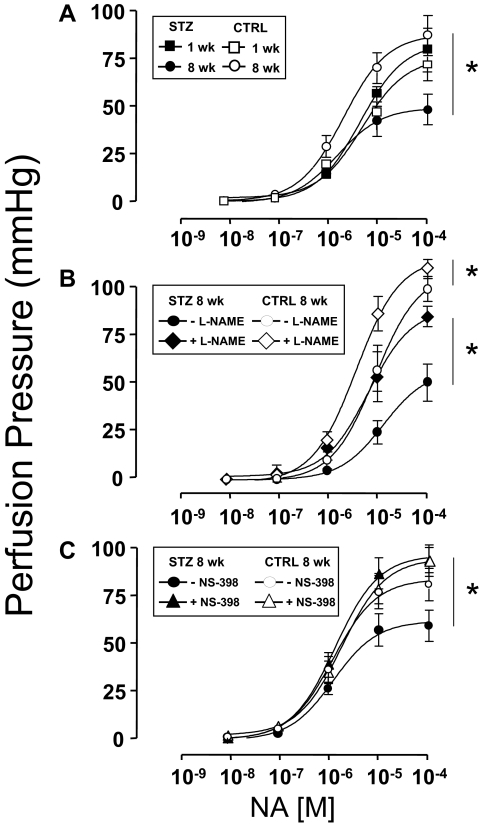Figure 5.
Both COX-2- and NO-dependent mechanisms participate in opposing endothelial dysfunction in STZ-induced diabetes. MVBs were isolated from mice treated with STZ (closed symbols) or vehicle control (open symbols) and prepared as described in Materials and Methods. A, Dose-response curves for NA-induced vasoconstriction were obtained in MVBs from mice 1 wk (squares) or 8 wk (circles) after treatment with STZ or vehicle control. Results are mean ± sem of 12 (STZ) and 10 (CTRL) independent experiments. NA-mediated vasoconstriction was significantly impaired in MVB from mice treated with STZ for 8 wk (vs. respective CTRL, P < 0.001). B, Dose-response curves for NA-mediated vasoconstriction were obtained in MVBs from mice 8 wk after treatment with STZ or vehicle control in the absence (circles) or presence (diamonds) of pretreatment with the NO synthase antagonist L-NAME (100 μm, 30 min). Results are mean ± sem of four (STZ) and five (CTRL) independent experiments. Inhibition of NO synthase significantly increased NA-mediated vasoconstriction in MVBs from mice treated with either STZ or vehicle control for 8 wk (vs. results without L-NAME pretreatment, P < 0.01). C, Dose-response curves for NA-mediated vasoconstriction were obtained in MVB from mice 8 wk after treatment with STZ or vehicle control in the absence (circles) or presence (triangles) of pretreatment with the specific COX-2 inhibitor NS-398 (10 μm, 30 min). Results are mean ± sem of eight (STZ) and seven (CTRL) independent experiments. Inhibition of COX-2 significantly increased NA-mediated vasoconstriction in MVB from mice treated with STZ for 8 wk (vs. results without NS-398 pretreatment, P < 0.01) but not in MVB from CTRL mice. Asterisks refer to significant differences found between indicated curves assessed by two way ANOVA for repeated measures.

